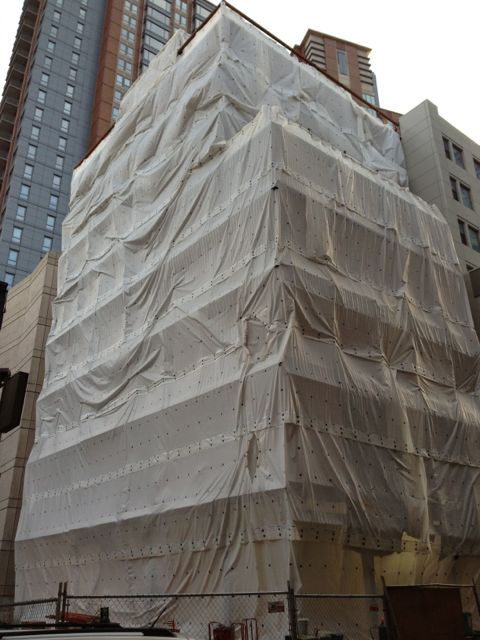The Stack Effect in Plastic

It was the stack effect that led me to Building Science Fight Club. I wrote about it two years ago and all hell broke loose in the comments, especially in the version I posted at Green Building Advisor. People get passionate about their building science, ya know.
Anyway, I’m in Boston this week for NESEA’s Building Energy conference. It’s cold here. A lot of buildings are in various stages of the construction process. Many have plastic draped over whole sides of them. In other words, it’s a great time to get some photos showing the stack effect.
I’ve always had to go online in our classes and show our students photos that other people took, but now I have some of my own, finally. The one above isn’t the best one I saw, but it’s pretty good. You can see the plastic being sucked in at the bottom and puffed out at the top, indicating negative pressure inside at the bottom and positive pressure at the top.
The photo below doesn’t show the stack effect. The plastic on that one is getting sucked in all over in this view. I think wind here was dominating stack since this was down near the water.

Allison A. Bailes III, PhD is a speaker, writer, building science consultant, and the founder of Energy Vanguard in Decatur, Georgia. He has a doctorate in physics and is the author of a bestselling book on building science. He also writes the Energy Vanguard Blog. For more updates, you can subscribe to Energy Vanguard’s weekly newsletter and follow him on LinkedIn.
Related Articles
Heat Rises…and Falls — Stack Effect, Air Movement, & Heat Flow
Who Knew the Stack Effect Could Be So Controversial?
You Do NOT Talk About Building Science Fight Club
NOTE: Comments are closed.
This Post Has 3 Comments
Comments are closed.

Sure is a high neutral
Sure is a high neutral pressure plane on that plastic coated building. Yes, very cool visual of the stack effect.
Oh, and computers…they gotta do something now and then to aggravate the daylights out of us. Just seems SOP. 🙂
That was a good catch. I don
That was a good catch. I don’t know if I’d have noticed that… 🙂
WIND is the dominant effect
WIND is the dominant effect in Oklahoma for sure, especially for a single story building.